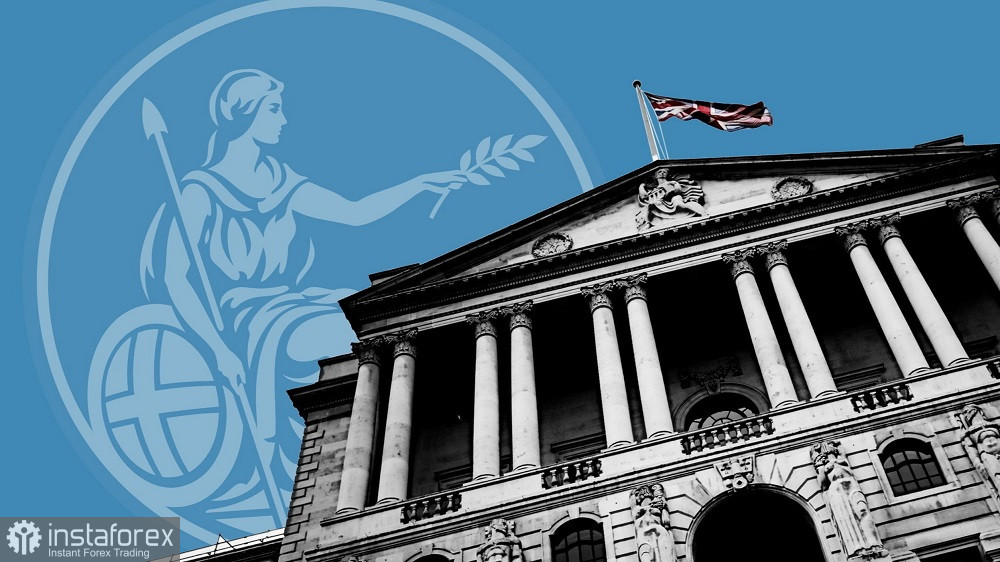The pound against the dollar is drifting near the 27 and 28 figures, awaiting the Bank of England's August meeting, which will take place on Thursday. In mid-July, the pound reached a three-month price high, testing the 1.3000 target for the first time since April. However, GBP/USD buyers failed to hold above the target. Over the following two weeks, the pair gradually but consistently declined, losing almost 300 pips overall. This week, bearish sentiments also prevail for the pair, but traders are cautious ahead of the announcement of the BoE's meeting results, especially since there is still some intrigue.
Scenario #1: Base case
The base scenario assumes a 25 basis point interest rate hike to 5.25%. The main argument in favor of this version is inflation. On one hand, key inflation indicators are well above the target level (which forces the central bank to take countermeasures), but on the other hand, the pace of inflation growth has been consistently slowing down (which allows for a "moderately aggressive" policy).

For example, the general consumer price index in June came in at 7.9% on an annual basis, while most experts predicted a decrease to 8.2%. The indicator demonstrates a downward trend for the fourth consecutive month. In monthly terms, the general CPI declined to 0.1%, with a forecast decline to 0.4%, the weakest growth rate since January of this year. The core consumer price index, excluding food and energy prices, declined to the target of 6.9% in June, while most analysts expected it to remain at the previous month's level of 7.1%.
Other inflation indicators also came out in the "red zone." In particular, the retail price index on an annual basis came in at 10.7% in June, with a forecast of a decrease to 10.9% (the weakest growth rate since March 2022). By the way, this index is used by British employers during wage negotiations. The producer price index collapsed to -2.7%, with a decline to -1.6% (the weakest result since August 2020). The producer price index for output also demonstrated a similar dynamic (0.1% YoY, forecast - 0.5%).
Other macroeconomic reports published during the previous month also support the moderately aggressive scenario. For example, the UK labor market report was quite weak—almost all components came out in the "red zone." The unemployment rate rose to 4.0% (although most experts were confident that the indicator would remain at 3.8%), and the number of unemployment benefit claims jumped by 25,000, while analysts predicted a more modest increase by 19,000.
UK GDP also disappointed, which contracted in May by 0.1%, while the previous month had recorded growth of 0.2%. The volume of industrial production decreased by 0.6% on a monthly basis and by 2.3% on an annual basis. The volume of production in the manufacturing sector declined by 1.2% YoY, with a forecast decline of 1.7%.
Summary: Inflation in the UK remains at an unacceptably high level (although it is decreasing actively), while other key macroeconomic indicators indicate negative trends in the economy. Such a disposition suggests that the Bank of England will likely settle for a 25-basis-point interest rate hike.
Scenario #2, Scenario #3: Doves and Hawks
Undoubtedly, other scenarios, alternative to the base one, cannot be ruled out.
The option of maintaining the status quo seems highly unlikely since, firstly, the consumer price index remains far from the target level, and pro-inflation indicators demonstrate an upward trend. For example, in the latest labor market report, the indicator of average earnings growth came in the "green zone," reflecting the corresponding trends. Including bonuses, wages increased by 6.9%—the strongest growth rate since April 2022.
Therefore, the option of a pause at the August meeting is effectively ruled out. However, ruling out the implementation of the "ultra-hawkish" scenario is not entirely possible.
In particular, currency strategists from Societe Generale warned their clients that the Bank of England could raise the interest rate by 50 basis points at once. They justified their position by pointing to a barrage of criticism from British politicians and journalists towards the English regulator for "fanning the flames of inflation by persistently maintaining an overly accommodative policy." Additionally, Societe Generale analysts pointed out that investors have been avoiding British bonds in recent months due to the prolonged inflation in the country. And, ultimately, the bank's experts again emphasize inflation in the services sector and the dynamics of wage growth—both indicators remain "uncomfortably high" in the context of achieving the target two percent inflation level.
Conclusions
Despite certain arguments in favor of the implementation of the "ultra-hawkish" scenario, in my opinion, the Bank of England will implement the base scenario tomorrow, implying a 25-basis-point rate increase.
This scenario has already been largely priced in, so the pound's reaction will depend on the wording of the accompanying statement and the rhetoric of the head of the Central Bank, Andrew Bailey. If the regulator indicates that the August rate hike is not the last one this year, GBP/USD may likely return to the 1.30 area. However, if the Bank's formulations are more cautious and "vague," the bearish pair will target the support level at 1.2650—at this price point, the lower line of the Bollinger Bands indicator coincides with the upper boundary of the Kumo cloud on the daily chart.





















